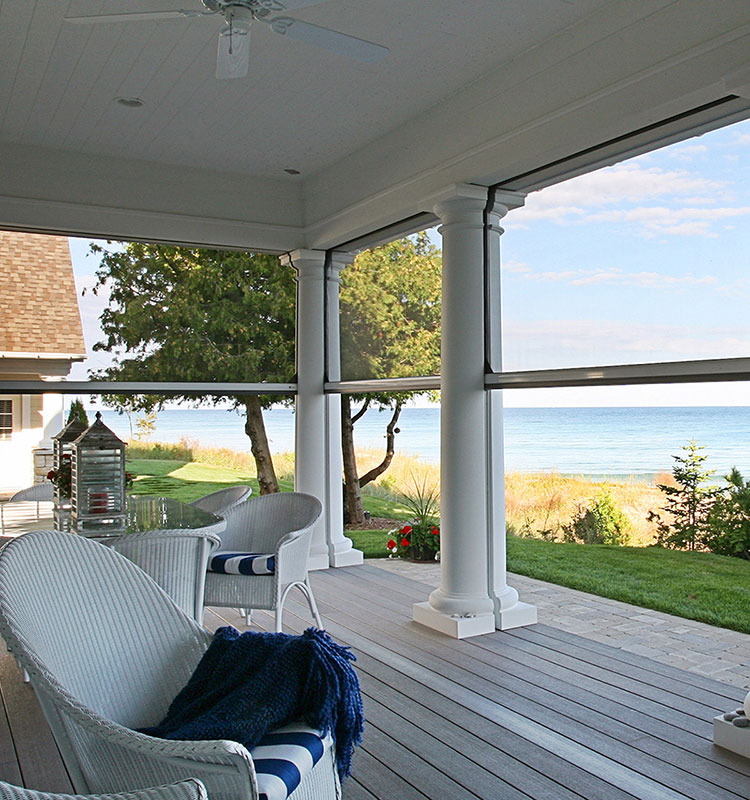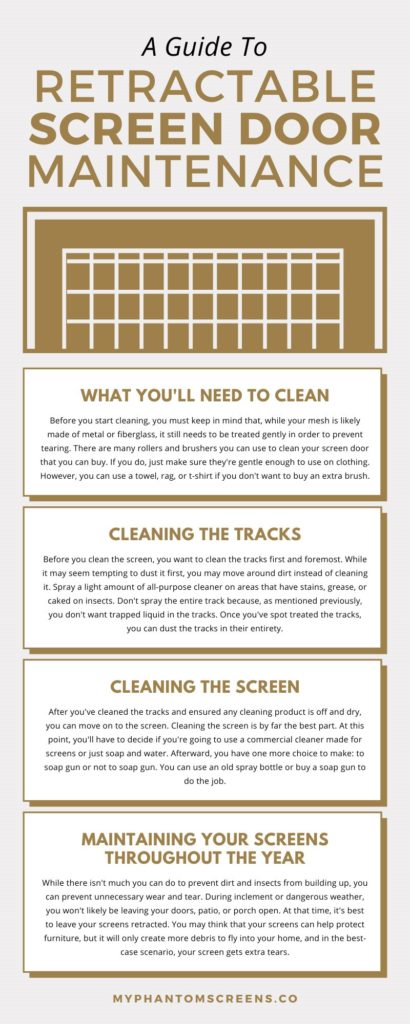
A Guide To Retractable Screen Door Maintenance
Published on August 23, 2022

Published on August 23, 2022

While no one wants their screens to make their home look dirty, retractable screen doors aren’t the problem, but rather a lack of care. Luckily, caring for and cleaning your retractable screens is easy, which is why this article will be your guide to retractable screen door maintenance.
Before you start cleaning, you must keep in mind that, while your mesh is likely made of metal or fiberglass, it still needs to be treated gently in order to prevent tearing. There are many rollers and brushers you can use to clean your screen door that you can buy. If you do, just make sure they’re gentle enough to use on clothing. However, you can use a towel, rag, or t-shirt if you don’t want to buy an extra brush.
In addition, while there are screen cleaners, you can also just use room-temperature water and soap in a spray bottle. If you have insects or dirt that are hard to clean, you may want to use a hose with a decent amount of pressure. Never use a pressure washer to clean a screen door unless your installer specifically tells you that you can. A pressure washer can easily create holes or wear out the screen. Even if you can use a pressure washer, avoid areas that look too shiny or thin, especially the edges and corners, as these are likely the areas that are the least structurally sound.
Ultimately, you need something to take out the loose dust and a way to apply the soap and water as well as a hose. The screen itself will air dry, likely overnight, so you can leave it down. If you have some stubborn dust, you can use a rug beater as long as you don’t use a full baseball swing.
To clean the tracks, an all-purpose cleaner and a simple rag or dust catcher will do the trick. Never spray water in any of the tracks, as excess water can get caught and cause early weathering. The best tool to use for this is a pole duster so you can get into all the nooks and crannies, but again, you can use a rag if you can’t get your hands on a pole duster. But once you have everything set up, you’re ready to start cleaning!
Before you clean the screen, you want to clean the tracks first and foremost. While it may seem tempting to dust it first, you may move around dirt instead of cleaning it. Spray a light amount of all-purpose cleaner on areas that have stains, grease, or caked on insects. Don’t spray the entire track because, as mentioned previously, you don’t want trapped liquid in the tracks. Once you’ve spot treated the tracks, you can dust the tracks in their entirety. Just make sure to change or wash out the duster often to prevent dragging dirt back and forth. Once the duster is full, clean it off or move on to a new one.
If you’ve done that but still notice rust stains, you may want to start spot treating again. If you have rust stains, you can use a rust remover, but water and vinegar work just as well, although you may need to leave it on longer. First, use a wet cloth on the rust spot and follow up with a soft toothbrush. If that doesn’t remove the stain, you can move on to the water and vinegar method. If neither of those options seems to work for you, that’s when you should move up to a commercial rust remover, but keep in mind the material of your tracks and screen frame. While it’s likely made of aluminum, you can never be too careful.
After you’ve cleaned the tracks and ensured any cleaning product is off and dry, you can move on to the screen. Cleaning the screen is by far the best part. At this point, you’ll have to decide if you’re going to use a commercial cleaner made for screens or just soap and water.
Afterward, you have one more choice to make: to soap gun or not to soap gun. You can use an old spray bottle or buy a soap gun to do the job. Either of these few methods will work, it just all depends on what’s easier for you to use. Both will work just fine.
Depending on how large your screen is, you may need to make a few batches of soap and water, but there’s no specific ratio. Just make sure you see some suds when you start scrubbing. It’s worth mentioning that your safest bet is to use a gentle soap. Don’t use on your screen what you wouldn’t use on your hands if you’re going to make your own cleaning solution. You could accidentally expose your mesh to the wrong chemicals, causing corrosion.
But before you start cleaning, give your screens a pass with the duster or rug beater and spray them with a hose to remove loose dirt. Never use a vacuum on a screen, as that can also cause tearing.
It’s best to clean your screen in parts instead of applying the solution first, as you may end up with dried-on soap. Go section by section and use a damp rag or soft brush—circular motion for a rag, up and down for a brush. Once you’ve cleaned your screens, you’re free to spot treat them if you need to, but after that, you’re ready to let them air dry. Typically, it takes five to eight hours for a screen to dry completely, but thick privacy mesh may take up to twelve.
While there isn’t much you can do to prevent dirt and insects from building up, you can prevent unnecessary wear and tear. During inclement or dangerous weather, you won’t likely be leaving your doors, patio, or porch open. At that time, it’s best to leave your screens retracted. You may think that your screens can help protect furniture, but it will only create more debris to fly into your home, and in the best-case scenario, your screen gets extra tears.
Finally, when your screens are not in use, retract them. Keeping them recoiled when not in use is the best way to avoid unnecessary damage. If you repeat these maintenance steps and clean your screens twice a year, your screens are bound to look better and last longer!
While it may seem like a lot, maintaining retractable screen doors is easy once you know the right steps. And if you’re in the market for a brand new screen, Phantom Screens of Central Indiana can have high-quality retractable patio screen doors installed in your home so you can enjoy the sun without the pests.

Once you’ve made contact with us at Phantom Screens of Central Indiana, we will prepare an estimate for you and schedule an installation date with you.
Based in Zionsville, Indiana, we are the region’s leading supplier of professionally installed Phantom Screens retractable insect screens and retractable solar screens. Custom made to blend seamlessly with your home’s décor we have retractable bug screens for doors, windows or large openings.
With a wide range of colors, mesh options and even motorized retractable screens, we have screens for every style of home and budget. Why not give us a call at 317.490.3481 for your FREE estimate.
Central Indiana
Illinois
Kentucky
Ohio